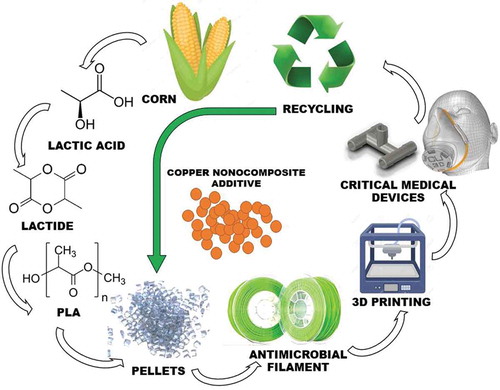Figures & data
Figure 1. Theoretical mechanisms for the enhanced antimicrobial behavior of additive manufacturing polymers. (a) Copper nanoparticles on a polymer structure present a stronger antimicrobial effect than microparticles or metal surfaces. Antimicrobial polymers facilitate the process of attaching the microorganism on the polymer surface triggering the diffusion of water through the polymer matrix. Water with dissolved oxygen reaches the surface of embedded metal nanoparticles allowing dissolution or corrosion processes releasing metal ions; metal ions reach the composite surface damaging the bacteria membrane. Afterward, metal ions can diffuse into the interior of the microorganism. (b) The antimicrobial mechanisms of nanoparticles of copper consist in producing cell membrane damage via copper ions that damage polyunsaturated fatty acid compromising the structure of the cell membrane and producing leakage of mobile cellular solutes resulting in cell death. The redox cycling between Cu2+ and Cu1+ can catalyze the production of highly reactive hydroxyl radicals, which can subsequently damage cell membrane lipids, proteins, DNA, RNA, and other biomolecules. Once copper and associated hydroxyl radicals are inside of the cell, it produces DNA denaturalization damaging helical structures. Copper also damage and alter proteins acting as a protein inactivator via RNA, useful to deactivate a wide range of viruses.

Table 1. Examples of open source critical medical devices.
Figure 2. The manufacturing process of antimicrobial critical medical devices using an antimicrobial polymer. The process starts with corn fermentation (corn to Lactic Acid), condensation (Lactide) and polymerization (Polylactic acid; PLA). The addition of copper nanocomposite additive to pellets at different concentrations allows the development of a multipurpose antimicrobial filament. The recyclable characteristics of this filament facilitate the production of new antimicrobial medical devices in austere environments.

